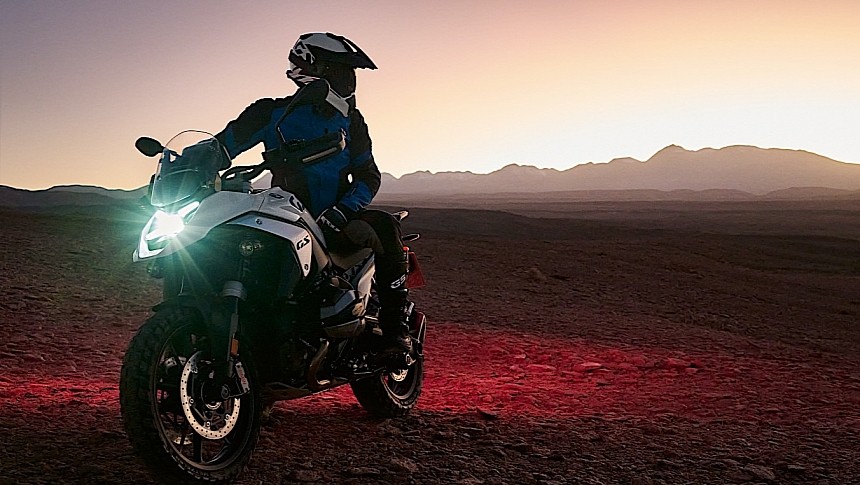German bike maker BMW Motorrad likes to call itself the inventor of the touring enduro segment, something that happened more than four decades ago, when the R 80 G/S first came to life. As such, it must also feel great pressure to keep leading the segment. And this is where the new R 1300 GS comes in.
Built on what the previous iteration had to offer, but significantly improved, the ride should at least in theory ensure the German's domination of the segment. Especially since the changes made to the new variant have to do with the bike's most important assets: the engine and its suspension system.
For the new R 1300 GS BMW will continue to offer the mighty boxer engine configuration it's so fond of. In this case, we're talking about a unit exactly 1,300cc in displacement, only now rocking a new camshaft drive arrangement and the gearbox located underneath.
This setup, along with some other tweaks BMW is likely unwilling to share, places the engine's output at 145 hp and 149 Nm of torque. Those are numbers that make the unit the most powerful boxer engine BMW ever made, taking the R 1300 GS with it to the same title.
As far as the suspension system is concerned, it has been revised to include a new and stiffer steel shell main frame, while the rear frame, made of steel until now, was replaced by a diecast aluminum one.
It's when it comes to optional equipment that the differences make themselves felt the most. For instance, riders can opt to get the Dynamic Suspension Adjustment (DSA) handling the front and rear damping with a corresponding adjustment of the spring rate. Furthermore, the new adaptive height control system allows the ride to be gifted with 20 mm more spring travel.
The bike can now be set up in four riding modes instead of three, namely Rain, Road, Eco, and Enduro. It comes fully loaded with Active Cruise Control (ACC), Front Collision Warning (FCW) and Lane Change Warning (SWW).
Visually, the new enduro king sets itself apart from its predecessor thanks to a new aluminum fuel tank and a redesigned LED headlight. There is a 6.5-inch TFT screen on board for infotainment needs, but also a charging compartment with an integrated USB socket for the rider's smartphone.
Overall, with the many changes it made BMW managed to shave 12 kg (26 pounds) off the R 1300 GS compared to the previous version making it an even more solid proposition in its segment.
The bike will be offered in four variants, namely Basic, Triple Black, GS Trophy, and Option 719 Tramuntana. As far as colors are concerned, the entry-level comes in Lightwhite solid paint, the Triple is painted black, the Trophy shows up in Racingblue metallic, while the top-of-the-range Tramuntana is wrapped in Aurelius Green.
The German bike maker will ask $18,895 for the cheapest of them all, and the bikes are expected to be on the dealers' lots in early 2024.
For the new R 1300 GS BMW will continue to offer the mighty boxer engine configuration it's so fond of. In this case, we're talking about a unit exactly 1,300cc in displacement, only now rocking a new camshaft drive arrangement and the gearbox located underneath.
This setup, along with some other tweaks BMW is likely unwilling to share, places the engine's output at 145 hp and 149 Nm of torque. Those are numbers that make the unit the most powerful boxer engine BMW ever made, taking the R 1300 GS with it to the same title.
As far as the suspension system is concerned, it has been revised to include a new and stiffer steel shell main frame, while the rear frame, made of steel until now, was replaced by a diecast aluminum one.
It's when it comes to optional equipment that the differences make themselves felt the most. For instance, riders can opt to get the Dynamic Suspension Adjustment (DSA) handling the front and rear damping with a corresponding adjustment of the spring rate. Furthermore, the new adaptive height control system allows the ride to be gifted with 20 mm more spring travel.
The bike can now be set up in four riding modes instead of three, namely Rain, Road, Eco, and Enduro. It comes fully loaded with Active Cruise Control (ACC), Front Collision Warning (FCW) and Lane Change Warning (SWW).
Visually, the new enduro king sets itself apart from its predecessor thanks to a new aluminum fuel tank and a redesigned LED headlight. There is a 6.5-inch TFT screen on board for infotainment needs, but also a charging compartment with an integrated USB socket for the rider's smartphone.
Overall, with the many changes it made BMW managed to shave 12 kg (26 pounds) off the R 1300 GS compared to the previous version making it an even more solid proposition in its segment.
The bike will be offered in four variants, namely Basic, Triple Black, GS Trophy, and Option 719 Tramuntana. As far as colors are concerned, the entry-level comes in Lightwhite solid paint, the Triple is painted black, the Trophy shows up in Racingblue metallic, while the top-of-the-range Tramuntana is wrapped in Aurelius Green.
The German bike maker will ask $18,895 for the cheapest of them all, and the bikes are expected to be on the dealers' lots in early 2024.


































